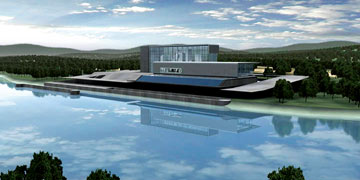|
NEWS NOTES
FutureGen gets a facelift
 U.S. Department of Energy |
| An artist’s rendition of the original FutureGen power plant in Mattoon, Ill. |
Here’s the conundrum: In a world of expensive energy, coal is cheap and plentiful. But burning coal to produce electricity releases billions of tons of carbon dioxide into the air each year. That’s why the Bush administration came up with a plan in 2003 to build FutureGen, a new coal-fired power plant that would capture and permanently store its own carbon dioxide emissions. By December 2007, the U.S. Department of Energy (DOE) had secured private investors, conducted an environmental assessment and selected a site — Mattoon, Ill. Just a month later, however, the agency pulled its funding, citing ballooning costs.
“The announcement itself was a surprise, although the underlying rationale is not surprising when looked at from the administration’s point of view,” says Bryan Hannegan of the Electric Power Research Institute in Palo Alto, Calif. “Unfortunately, we’re in a world where the cost to build any energy infrastructure has gone through the roof in the past few years.”
Although DOE’s announcement is likely a death knell for the Mattoon plant, it’s not the end of FutureGen. Instead of paying 75 percent of the costs associated with building a clean-coal demonstration plant with carbon capture and storage (CCS) technology, DOE now plans to subsidize CCS for private companies that already have plans to construct new plants. According to DOE, that means capturing at least twice as much carbon dioxide and getting CCS technology to market in the near future. “The goal is to see some of these facilities built in the same timeframe or even sooner than [the original] FutureGen,” says Scott Tinker, director of the Bureau of Economic Geology at the University of Texas at Austin.
The government has been talking about CCS for more than a decade. As a concept, it’s relatively simple. FutureGen, like many proposed power plants, was designed to turn coal into gas and siphon off the carbon dioxide before the gas is combusted. That carbon dioxide would be compressed, transported by pipeline to wells and then injected hundreds of meters belowground into sedimentary formations, where it would become trapped in the saltwater that fills tiny pores in the rock.
A few pilot projects have shown that CCS can succeed, at least in the short term. But the technology has never been used to offset coal combustion on a large scale. “It’s a big challenge,” says Lynn Orr, project director of Stanford University’s Global Climate & Energy Project in Palo Alto, Calif. “There are plenty of geoscience issues that will have to be studied and worked out.”
DOE plans to limit new FutureGen funding to companies that are willing to capture at least a million tons of carbon dioxide each year. That’s nearly enough compressed carbon dioxide to fill the Empire State Building. In fact, no power plant in the world is currently able to implement CCS on that scale. Yet the U.S. electricity industry alone emits close to 2.4 billion tons per year, Hannegan says.
Not everyone agrees, however, that scrapping the original project is the best way to make CCS a reality. “As far as I can tell, the collapse of the [original] FutureGen project is yet more evidence of the Bush administration’s lack of commitment to meaningful and timely reductions in greenhouse gas emissions,” says Ken Caldeira, a scientist at the Carnegie Institution’s Department of Global Ecology at Stanford University. Key members of the House Committee on Science and Technology have expressed concern as well, asking the Government Accountability Office to examine the administration’s rationale for abandoning the original FutureGen. Orr says that DOE’s decision to fund CCS on multiple private plants makes some sense, but he adds that it will likely delay the process.
“If we’re serious about addressing climate change then we need to get to work on large-scale CCS,” Hannegan says. “Others may have disagreements about whether FutureGen was the right way to go, but if we spend too much time arguing about it we will lose valuable time on other potential CCS projects.”

 Subscribe
Subscribe


